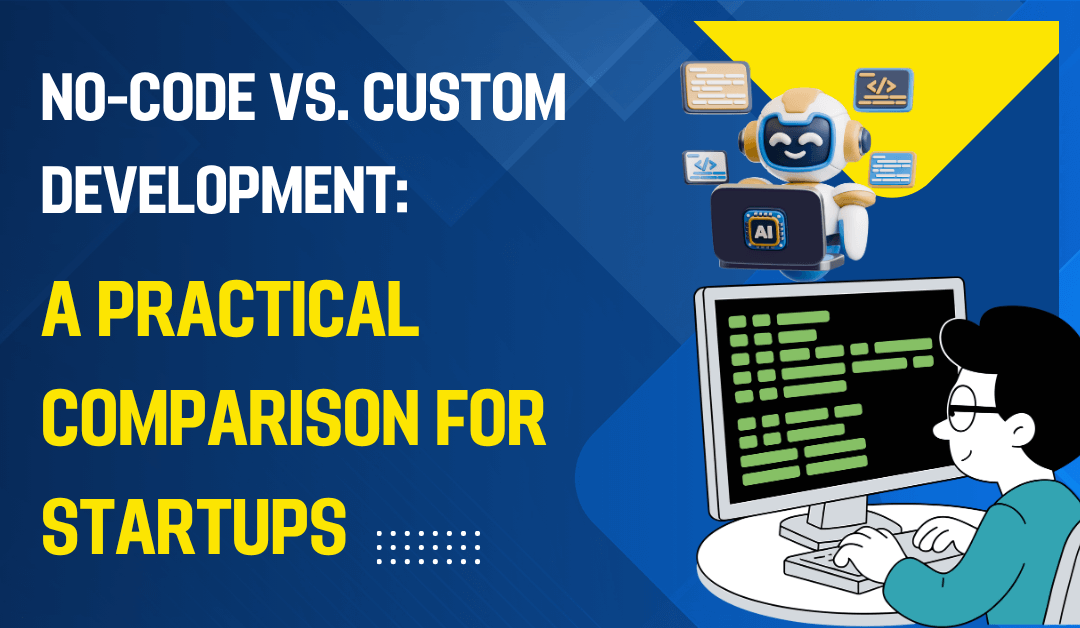No-Code vs. Custom Development
For every founder with a groundbreaking idea, the first major hurdle is technical: How do we actually build this? The answer isn’t as simple as “hire a developer.” You’re faced with a fundamental choice: the blazing speed of No-Code platforms or the limitless power of Custom Development.
This isn’t about which is universally “better.” It’s about which is better for your startup, right now. Let’s break down this critical decision with a practical, no-nonsense comparison.
The 30-Second Summary: A Tale of Two Philosophies
- No-Code: Think of it as building with sophisticated Lego blocks. You use visual builders and pre-made components to assemble your application quickly and with little to no coding. It’s about speed and accessibility.
- Custom Development: This is building from raw materials like wood and steel. Developers write code from scratch, offering total freedom to create anything you can imagine. It’s about power and precision.
The Head-to-Head Comparison
|
Feature |
No-Code Development |
Custom Development |
|
🏃♂️ Speed to MVP |
Extremely Fast (Weeks, not months). Ideal for rapid validation. |
Slower (Months+). Requires planning, design, and coding from the ground up. |
|
💵 Upfront Cost |
Low to Moderate. Subscription-based platform fees. |
High. Salaries or fees for experienced developers/agencies. |
|
🔧 Flexibility & Control |
Limited. You are confined to the platform’s capabilities and pre-built connectors. |
Total. You own the code and can build any feature, integrate any service, and customize every detail. |
|
📈 Scalability |
Platform-Dependent. Can hit ceilings. Scaling may require migrating to a custom solution later. |
Virtually Unlimited. Can be architectured from day one to handle millions of users. |
|
🛠️ Maintenance & Ownership |
Managed by Platform. Easier for non-techies, but you don’t own the core IP. Risk of platform changes. |
Your Responsibility. Requires a technical team, but you have full ownership and control. |
|
🎯 Ideal For |
MVPs, internal tools, simple marketplaces, content portals, proof-of-concept demos. |
Complex SaaS products, data-intensive applications, unique algorithms, platforms requiring deep integrations. |
When to Choose No-Code: The Fast Lane to Validation
No-Code shines when your primary goal is to test a business hypothesis and get to market quickly.
Choose No-Code if:
- You Need an MVP Yesterday: You have a simple idea and need a working prototype to show investors or early customers to gauge interest.
- You’re a Non-Technical Founder: You can’t code and don’t have the budget to hire a full development team yet.
- Your Workflow is Standard: Your app fits common patterns like a directory, a booking system, or a basic social network. Platforms like Bubble, Adalo, and Softr are perfect for this.
- Budget is a Primary Constraint: You need to conserve cash for marketing, sales, and customer acquisition.
Real-World Example: A founder wants to validate a niche membership community. Using a no-code tool like Circle.so or Memberstack with Webflow, they can launch a paid community in a weekend without writing a single line of code.
When to Choose Custom Development: Building for the Long Haul
Custom Development is your best bet when your product’s core value is its unique, complex, or highly scalable technology.
Choose Custom Development if:
- Your Idea is Technically Unique: You’re building a complex algorithm, a real-time trading platform, or a product with proprietary technology that can’t be replicated with no-code blocks.
- Scalability is a Core Concern: You anticipate rapid user growth and need an architecture that can scale seamlessly without being limited by a platform’s tiered plans.
- You Require Deep Integrations: Your product needs to connect with multiple legacy systems or APIs in a highly specific way.
- You Plan to Sell or License Your Tech: Full ownership of the codebase is a valuable business asset for future acquisition or licensing.
Example: A startup is developing an AI-powered project management tool that requires advanced data processing and real-time collaboration capabilities. This level of customization and performance demands a custom-built solution using frameworks like React or Node.js.
The Hybrid Approach: The Best of Both Worlds?
Many savvy startups are adopting a hybrid strategy. They use No-Code to validate and generate initial revenue, then reinvest that revenue into Custom Development for a more robust, scalable version.
How it works:
- Phase 1 (Validation): Build and launch your MVP on a no-code platform. Get users, gather feedback, and prove there’s a market.
- Phase 2 (Investment): Use the traction and data from your no-code MVP to raise a seed round or fund development internally.
- Phase 3 (Scale): Hire a development team to rebuild a custom version based on the validated learnings, designed for scale from the outset.
This approach mitigates the risk of spending significant time and money on an unproven idea while still building a long-term, defensible technology asset.
The Final Verdict: It’s About Your Stage and Strategy
Stop thinking of this as a permanent, irreversible choice. Instead, frame it as a strategic decision based on your startup’s current stage.
- Are you in the Problem/Solution Fit stage? Your goal is to learn. No-Code is likely your champion.
- Are you progressing to Product/Market Fit and Scale? Your goal is to build a durable, market-leading product. Custom Development becomes essential.
The most successful founders aren’t ideologues; they are pragmatists. They choose the right tool for the job at hand, always keeping their eyes on the ultimate prize: building a product that customers love and that can grow into a sustainable business.
What’s your experience? Are you leaning towards no-code or custom development for your startup? Share your thoughts

